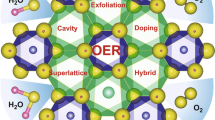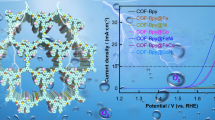Abstract
We have designed a polymer, hc-TBtd-COP incorporating a Wurster-type redox-active building unit for the in situ reduction and nucleation of platinum nanoparticles which forms an organic polymer-wrapped metal nanoparticle composite. This composite exhibits exceptional mass activity (MA) (about 5 times larger than 20% Pt/C at 0.9 V vs. RHE) and specific activity (SA) (approximately 2 times larger than 20% Pt/C at 0.9 V vs. RHE) for the oxygen reduction reaction. The efficient electrocatalysis results from higher catalytic site dispersion and superior atom utilization efficiency. This research contributes to the advancement of composite materials for enhanced electrocatalytic performance.
Graphical abstract





Similar content being viewed by others
Data availability
The datasets generated during the current study are available from the corresponding author upon reasonable request.
References
B. Garlyyev, K. Kratzl, M. Rück, J. Michalička, J. Fichtner, J.M. Macak, T. Kratky, S. Günther, M. Cokoja, A.S. Bandarenka, Optimizing the size of platinum nanoparticles for enhanced mass activity in the electrochemical oxygen reduction reaction. Angew. Chem. Int. Ed. 58, 9596 (2019). https://doi.org/10.1002/anie.201904492
M. Eckardt, C. Gebauer, Z. Jusys, M. Wassner, N. Hüsing, R.J. Behm, Oxygen reduction reaction activity and long-term stability of platinum nanoparticles supported on titania and titania-carbon nanotube composites. J. Power. Sources 400, 580 (2018). https://doi.org/10.1016/j.jpowsour.2018.08.036
V. Mastronardi, E. Magliocca, J.S. Gullon, R. Brescia, P.P. Pompa, T.S. Miller, M. Moglianetti, Ultrasmall, coating-free, pyramidal platinum nanoparticles for high stability fuel cell oxygen reduction. ACS Appl. Mater. & Interfaces 14, 36570 (2022). https://doi.org/10.1021/acsami.2c07738
I.H. Hafez, M.R. Berber, T. Fujigaya, N. Nakashima, Enhancement of platinum mass activity on the surface of polymer-wrapped carbon nanotube-based fuel cell electrocatalysts. Sci. Rep. 4, 6295 (2014). https://doi.org/10.1038/srep06295
M. Asahi, S.-I. Yamazaki, N. Taguchi, T. Ioroi, Facile approach to enhance oxygen reduction activity by modification of platinum nanoparticles by melamine-formaldehyde polymer. J. Electrochem. Soc. 166, F498 (2019). https://doi.org/10.1149/2.0641908jes
H. Zhao, G. Yu, M. Yuan, J. Yang, D. Xu, Z. Dong, Ultrafine and highly dispersed platinum nanoparticles confined in a triazinyl-containing porous organic polymer for catalytic applications. Nanoscale 10, 21466 (2018). https://doi.org/10.1039/C8NR05756G
M. Xu, C. Lai, X. Liu, B. Li, M. Zhang, F. Xu, S. Liu, L. Li, L. Qin, H. Yi, COF-confined catalysts: from nanoparticles and nanoclusters to single atoms. J. Mater. Chem. A 9, 24148 (2021). https://doi.org/10.1039/D1TA04439G
L. Liu, A. Corma, Confining isolated atoms and clusters in crystalline porous materials for catalysis. Nat. Rev. Mater. 6, 244 (2021). https://doi.org/10.1038/s41578-020-00250-3
S. Chen, Y. Zheng, B. Zhang, Y. Feng, J. Zhu, J. Xu, C. Zhang, W. Feng, T. Liu, Cobalt, nitrogen-doped porous carbon nanosheet-assembled flowers from metal-coordinated covalent organic polymers for efficient oxygen reduction. ACS Appl. Mater. Interfaces 11, 1384 (2019). https://doi.org/10.1021/acsami.8b16920
S. Bhunia, A. Peña-Duarte, H. Li, H. Li, M.F. Sanad, P. Saha, M.A. Addicoat, K. Sasaki, T.A. Strom, M.J. Yacamán, C.R. Cabrera, R. Seshadri, S. Bhattacharya, J.-L. Brédas, L. Echegoyen, [2,1,3]-Benzothiadiazole-spaced co-porphyrin-based covalent organic frameworks for O2 reduction. ACS Nano 17, 3492 (2023). https://doi.org/10.1021/acsnano.2c09838
J.-M. Seo, H.-J. Noh, J.-P. Jeon, H. Kim, G.-F. Han, S.K. Kwak, H.Y. Jeong, L. Wang, F. Li, J.-B. Baek, Conductive and ultrastable covalent organic framework/carbon hybrid as an ideal electrocatalytic platform. J. Am. Chem. Soc. 144, 19973 (2022). https://doi.org/10.1021/jacs.2c08344
J. Quinson, A. Dworzak, S.B. Simonsen, L.T. Kuhn, K.M. Jensen, A. Zana, M. Oezaslan, J.J. Kirkensgaard, M. Arenz, Surfactant-free synthesis of size controlled platinum nanoparticles: insights from in situ studies. Appl. Surf. Sci. 549, 149263 (2021). https://doi.org/10.1016/j.apsusc.2021.149263
J. Quinson, J. Mathiesen, J. Schröder, A. Dworzak, F. Bizzotto, A. Zana, S.B. Simonsen, L.T. Kuhn, M. Oezaslan, K.Ø. Jensen, Teaching old precursors new tricks: fast room temperature synthesis of surfactant-free colloidal platinum nanoparticles. J. Colloid Interface Sci. 577, 319 (2020). https://doi.org/10.1016/j.jcis.2020.05.078
M. Peng, C. Dong, R. Gao, D. Xiao, H. Liu, D. Ma, Fully exposed cluster catalyst (FECC): toward rich surface sites and full atom utilization efficiency. ACS Cent. Sci. 7, 262 (2020). https://doi.org/10.1021/acscentsci.0c01486
T. Imaoka, Y. Akanuma, N. Haruta, S. Tsuchiya, K. Ishihara, T. Okayasu, W.-J. Chun, M. Takahashi, K. Yamamoto, Platinum clusters with precise numbers of atoms for preparative-scale catalysis. Nat. Commun. 8, 688 (2017). https://doi.org/10.1038/s41467-017-00800-4
S. Wang, Q. He, C. Wang, H. Jiang, C. Wu, S. Chen, G. Zhang, L. Song, Active Sites engineering toward superior carbon-based oxygen reduction catalysts via confinement pyrolysis. Small 14, 1800128 (2018). https://doi.org/10.1002/smll.201800128
K. Jiang, S. Back, A.J. Akey, C. Xia, Y. Hu, W. Liang, D. Schaak, E. Stavitski, J.K. Nørskov, S. Siahrostami, Highly selective oxygen reduction to hydrogen peroxide on transition metal single atom coordination. Nat. Commun. 10, 3997 (2019). https://doi.org/10.1038/s41467-019-11992-2
Z. Lu, G. Chen, S. Siahrostami, Z. Chen, K. Liu, J. Xie, L. Liao, T. Wu, D. Lin, Y. Liu, T.F. Jaramillo, J.K. Nørskov, Y. Cui, High-efficiency oxygen reduction to hydrogen peroxide catalysed by oxidized carbon materials. Nat. Catal. 1, 156 (2018). https://doi.org/10.1038/s41929-017-0017-x
W. Wang, L. Zhang, T. Wang, Z. Zhang, X. Wang, C. Cheng, X. Liu, Inner-pore reduction nucleation of palladium nanoparticles in highly conductive wurster-type covalent organic frameworks for efficient oxygen reduction electrocatalysis. J. Energy Chem. 77, 543 (2023). https://doi.org/10.1016/j.jechem.2022.11.032
J.M. Rotter, R. Guntermann, M. Auth, A. Mähringer, A. Sperlich, V. Dyakonov, D.D. Medina, T. Bein, Highly conducting Wurster-type twisted covalent organic frameworks. Chem. Sci. 11, 12843 (2020). https://doi.org/10.1039/D0SC03909H
D. Taylor, S.J. Dalgarno, Z. Xu, F. Vilela, Conjugated porous polymers: incredibly versatile materials with far-reaching applications. Chem. Soc. Rev. 49, 3981 (2020). https://doi.org/10.1039/C9CS00315K
K. Jie, Y. Zhou, Q. Sun, B. Li, R. Zhao, D.-E. Jiang, W. Guo, H. Chen, Z. Yang, F. Huang, S. Dai, Mechanochemical synthesis of pillar[5]quinone derived multi-microporous organic polymers for radioactive organic iodide capture and storage. Nat. Commun. 11, 1086 (2020). https://doi.org/10.1038/s41467-020-14892-y
M.M. Abdelnaby, T.A. Saleh, M. Zeama, M.A. Abdalla, H.M. Ahmed, M.A. Habib, Azo-Linked porous organic polymers for selective carbon dioxide capture and metal ion removal. ACS Omega 7, 14535 (2022). https://doi.org/10.1021/acsomega.1c05905
B. Quan, S.-H. Yu, D.Y. Chung, A. Jin, J.H. Park, Y.-E. Sung, Y. Piao, Single source precursor-based solvothermal synthesis of heteroatom-doped graphene and its energy storage and conversion applications. Sci. Rep. 4, 5639 (2014). https://doi.org/10.1038/srep05639
D. Dang, H. Zou, Z. Xiong, S. Hou, T. Shu, H. Nan, X. Zeng, J. Zeng, S. Liao, High-performance, ultralow platinum membrane electrode assembly fabricated by in situ deposition of a Pt shell layer on carbon-supported Pd nanoparticles in the catalyst layer using a facile pulse electrodeposition approach. ACS Catal. 5, 4318 (2015). https://doi.org/10.1021/acscatal.5b00030
J. Yang, S.H. Kim, S.K. Kwak, H.-K. Song, Curvature-induced metal-support interaction of an islands-by-islands composite of platinum catalyst and carbon nano-onion for durable oxygen reduction. ACS Appl. Mater. Interfaces 9, 23302 (2017). https://doi.org/10.1021/acsami.7b04410
L. Jiao, E. Liu, S. Hwang, S. Mukerjee, Q. Jia, Compressive strain reduces the hydrogen evolution and oxidation reaction activity of platinum in alkaline solution. ACS Catal. 11, 8165 (2021). https://doi.org/10.1021/acscatal.1c01723
T. Xia, J. Liu, S. Wang, C. Wang, Y. Sun, L. Gu, R. Wang, Enhanced catalytic activities of NiPt truncated octahedral nanoparticles toward ethylene glycol oxidation and oxygen reduction in alkaline electrolyte. ACS Appl. Mater. Interfaces 8, 10841 (2016). https://doi.org/10.1021/acsami.6b01115
C.-S. Liu, X.-C. Liu, G.-C. Wang, R.-P. Liang, J.-D. Qiu, Preparation of nitrogen-doped graphene supporting Pt nanoparticles as a catalyst for oxygen reduction and methanol oxidation. J. Electroanal. Chem. 728, 41 (2014). https://doi.org/10.1016/j.jelechem.2014.06.024
W. Chen, Q. Xiang, T. Peng, C. Song, W. Shang, T. Deng, J. Wu, Reconsidering the benchmarking evaluation of catalytic activity in oxygen reduction reaction. iScience (2020). https://doi.org/10.1016/j.isci.2020.101532
J. Wang, G. Yin, Y. Shao, Z. Wang, Y. Gao, Platinum deposition on multiwalled carbon nanotubes by ion-exchange method as electrocatalysts for oxygen reduction. J. Electrochem. Soc. 154, B687 (2007). https://doi.org/10.1149/1.2737343
Acknowledgments
This work is supported as part of the Center for Alkaline Based Energy Solutions (CABES), an Energy Frontier Research Center funded by the U.S. Department of Energy (DOE), Office of Science, Basic Energy Sciences (BES), under Award # DE-SC0019445. We would also like to acknowledge the financial support from NSF for the acquisition of the XPS equipment (NSF/CHEM 2216473) and the support from the XPS Surface Characterization Facility at the University of Texas at El Paso.
Funding
Center for Alkaline Based Energy Solutions (CABES), an Energy Frontier Research Center funded by the U.S. Department of Energy (DOE), Office of Science, Basic Energy Sciences (BES), under Award # DE-SC0019445.
Author information
Authors and Affiliations
Contributions
SB and CRC performed the conception and design of this paper. SB and SC performed experiments. All authors read and approved the final manuscript.
Corresponding author
Ethics declarations
Conflict of interest
The authors declare no competing financial interest.
Additional information
Publisher's Note
Springer Nature remains neutral with regard to jurisdictional claims in published maps and institutional affiliations.
Supplementary Information
Below is the link to the electronic supplementary material.
Rights and permissions
Springer Nature or its licensor (e.g. a society or other partner) holds exclusive rights to this article under a publishing agreement with the author(s) or other rightsholder(s); author self-archiving of the accepted manuscript version of this article is solely governed by the terms of such publishing agreement and applicable law.
About this article
Cite this article
Bhunia, S., Chatterjee, S. & Cabrera, C.R. Platinum nanoparticle synthesis in engineered organic nanoscale reactors for efficient oxygen electro-reduction in alkaline conditions. MRS Communications (2024). https://doi.org/10.1557/s43579-024-00547-2
Received:
Accepted:
Published:
DOI: https://doi.org/10.1557/s43579-024-00547-2




